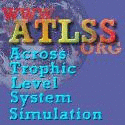



 |
 |
 |
 |
Introduction
This page contains data and information describing Across Trophic Level System
Simulation (ATLSS) Model runs made in support of the Initial Comprehensive Everglades Restoration Plan (CERP) Update (ICU).
Background information about CERP can be found at the
CERP Everglades Plan
web-site, describing
REstoration COordination and VERification
(RECOVER) and the
the Regional Evaluation Team (RET) .
ATLSS models are considered in this context to be System Wide Models in that they cover the entire
region involved in the CERP effort. Other examples of System Wide Models include the
South Florida Water Management Model (SFWMM) ,
and the Everglades Landscape Model (ELM) .
Additional information concerning the ATLSS models may be found at the
ATLSS web-site
and the ATLSS section of the
South Florida Information Access (SOFIA) web-site.
The
CERP/RECOVER System Wide Modeling page provides detailed descriptions of the hydrology
scenarios being analyzed.
This collection of pages present results of a variety of
ATLSS models as a complement to the Habitat Suitability Index
(HSI) Models developed by the South Florida Water Management District.
SFWMM HSI
models operate at a coarser spatial resolution and are designed with
different assumptions from the ATLSS models. In general, ATLSS results
are displayed at a spatial
resolution of 500 meters, although they have a finer underlying spatial
resolution. SFWMD HSI models generally operate at a 2 mile scale of spatial
resolution.
Both sets of models utilize the CERP/RECOVER hydrologic scenarios.
The CERP/RECOVER System Wide Modeling page provides information about
hydrology scenarios and displays
performance measures for the
SFWMD HSI Models
are also described (Select "Habitat Suitability Indices" from the "Search by Topic" section and
then click on the "Update Maps & Figures" button).
Four of the ATLSS Spatially Explicit Index (SESI) models were selected
to be utilized in this phase of the CERP/RECOVER
effort. The species modeled are the American Alligator, White-tailed
Deer, and Short- and Long-legged Wading Birds.
Description of output
Three types of ATLSS model outputs are available on this site. The first type,
"comparison maps," displays three map panels. The first,
or left, panel contains a spatial
display of the index values for a scenario (usually an "alternative" scenario). The third, or right, panel
contains the spatial display of another scenario (typically the "base" scenario). The second, or middle,
panel displays a difference map that represents the cell-by-cell difference
between the
two scenarios. The second type of output available is line graphs
displaying yearly SESI index values
averaged over groups of
Indicator Regions.
The final type of output is binary output files produced by the ATLSS
SESI models. These files are designed to be viewable by the
ATLSS Data Viewer .